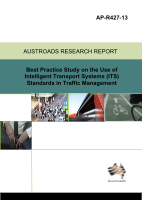Traffic Management

- Publication no: AP-R427-13
- ISBN: 978-1-921991-74-5
- Published: 11 March 2013
- PDF (free) Download
This research report reviews practice and standards for the implementation of Intelligent transport systems (ITS) Standards in traffic management and proposes a best practice framework for Australia and New Zealand.
ITS deployment is based on diverse regional and jurisdictional standards and specifications. The US National Transportation Communications for Intelligent Transportation System Protocol (NTCIP) suite of ITS communications standards was found to largely exceed the ANZ requirements with only a few exceptions such as video signal transmission. The report recommends a migration of Centre to Field (C2F) communications to NTCIP as a nationally harmonised standard. It has been determined that the traffic signal network, which is already heavily networked on the SCATS and STREAMS platforms, should not be migrated to NTCIP due to the potentially high costs without commensurate additional benefit.
- 1. INTRODUCTION
- 1.1. Objectives
- 1.2. Intelligent Transport Systems
- 1.3. Traffic Management and Operations
- 1.4. Approach to Best Practice Use of ITS Standards
- 1.5. Benefits of Standardisation
- 1.6. Report Structure
- 2. CURRENT PRACTICE IN ITS STANDARDS FOR TRAFFIC MANAGEMENT
- 2.1. Information Requested
- 2.2. Respondents
- 2.2.1. Privacy
- 2.3. Information Gathered
- 2.3.1. ITS Industry Comments and Opinions
- 2.4. Analysis of Information Received: Protocols
- 2.4.1. Analysis of Protocol Information
- 2.4.2. Protocols used by State Authorities
- 2.4.3. Protocols Used by Private Motorways
- 2.4.4. The Serco Spec 4596-325 v4.0 CMCS Protocol for the Traffic Sub-Centre
- 2.4.5. The RTA TSI-SP-003 Protocol for Field Devices
- 2.5. ITS Devices in Use
- 2.5.1. Typical ITS Physical Architecture
- 3. ITS STANDARDS SELECTION
- 3.1. International ITS Standards Applicable to Traffic Management
- 3.2. NTCIP Protocols
- 3.2.1. NTCIP Protocol Concept
- 3.2.2. Example – Dynamic Message Sign MIB
- 4. TRAFFIC MANAGEMENT ITS ARCHITECTURE AND FRAMEWORK
- 4.1. Attributes of the Hierarchical Functional Model
- 4.1.1. Information Aggregation
- 4.1.2. Immediacy of Information
- 4.1.3. Interrelationship between Functions
- 4.1.4. Temporal Requirements
- 4.1.5. Span of Control
- 4.2. Traffic Management Centre Functional Profile
- 4.3. Generic ITS Device Functional Framework
- 4.3.1. Description of Generic Device Categories
- 4.4. ITS Field Device Functional Profiles
- 4.4.1. Signals Functional Profile
- 4.4.2. Data Collection & Monitoring and Transport Sensor Systems Functional Profiles
- 4.4.3. Dynamic Message Signs Functional Profile
- 4.4.4. Closed Circuit TV Functional Profile
- 4.4.5. Environmental Sensor Stations Functional Profile
- 4.4.6. Electrical and Lighting Management Systems Functional Profile
- 4.4.7. Emergency Telephones
- 5. Best Practice Use of ITS Standards
- 5.1. Best Practice Framework
- 6. Findings and Recommendations
- 6.1. Governance
- 6.2. Migration to International ITS Standards
- REFERENCES
- APPENDIX 1 ITS SPECIFICATIONS AND STANDARDS USED IN AUSTRALIA AND NEW ZEALAND
- APPENDIX 2 GLOSSARY OF TERMS
- APPENDIX 3 DETAILED COMPARISON OF NTCIP AND RTA PROTOCOL FOR DYNAMIC MESSAGE SIGNS
